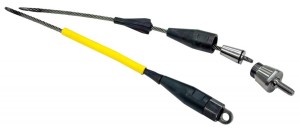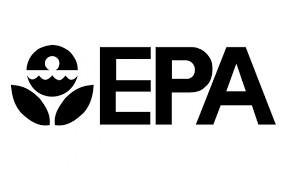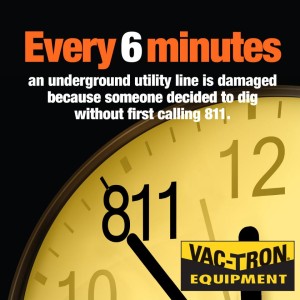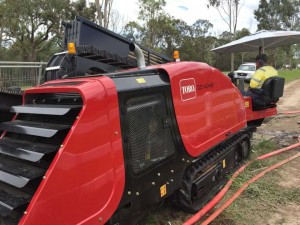Uncategorized
 AURORA, Ill.—TT Technologies, Aurora, Ill., offers a wide range of plastic pipe splitting heads developed by working directly with gas utilities to create optimum splitting head configurations. The designs are capable of splitting and replacing plastic gas service and main lines from ½-inch to 4 inches in diameter. The hardened heat-treated steel cutting blades are available in various designs and sizes to best match the type of plastic host pipe, as well as soil conditions. For service line splitting, the splitting heads are paired with a Mini Grundotugger winch or pulled with a backhoe. For main line splitting, a larger Grundowinch cable pulling system is used.
AURORA, Ill.—TT Technologies, Aurora, Ill., offers a wide range of plastic pipe splitting heads developed by working directly with gas utilities to create optimum splitting head configurations. The designs are capable of splitting and replacing plastic gas service and main lines from ½-inch to 4 inches in diameter. The hardened heat-treated steel cutting blades are available in various designs and sizes to best match the type of plastic host pipe, as well as soil conditions. For service line splitting, the splitting heads are paired with a Mini Grundotugger winch or pulled with a backhoe. For main line splitting, a larger Grundowinch cable pulling system is used.
During the process, small launch and exit pits are dug at either end of the service or main line being replaced. A winch cable is rodded from the exit pit, through the existing line, to the launch pit. The splitting head configuration is attached and then pulled through the exiting line. An expander forces the split pipe into the surrounding soil.
For more information visit www.tttechnologies.com.
Uncategorized

EPA developed the NCOD to satisfy the statutory requirements set by Congress in the 1996 amendments to the Safe Drinking Water Act (SDWA) to maintain a national drinking water contaminant occurrence database using samples data for both regulated and unregulated contaminants in public water systems.
This site describes water sample analytical data that EPA is currently using and has used in the past for analysis, rulemaking, and rule evaluation. The data have been checked for data quality and analyzed for national representativeness.
Click here for more information and to read data links.
Source: EPA.gov
Uncategorized
Vac-Tron first took shape in October of 1994 when Don Buckner founded American  Manufacturing and Machine, Inc., out of his garage with his son, Donnie Jr. Forged from their desire to “make something better” — the “virtual manufacturing” company relied on subcontractors to build and sell pumper and septic-tank trucks across the U.S. While in this role, Buckner saw a need for innovation in the trenchless industry, which was, at the time, marked by disastrous underground utility strikes. Soon, Buckner developed a revolutionary, well-made industrial vacuum system that could safely locate underground utilities — without the risk of a strike — and Vac-Tron was born.
Manufacturing and Machine, Inc., out of his garage with his son, Donnie Jr. Forged from their desire to “make something better” — the “virtual manufacturing” company relied on subcontractors to build and sell pumper and septic-tank trucks across the U.S. While in this role, Buckner saw a need for innovation in the trenchless industry, which was, at the time, marked by disastrous underground utility strikes. Soon, Buckner developed a revolutionary, well-made industrial vacuum system that could safely locate underground utilities — without the risk of a strike — and Vac-Tron was born.
Vac-Tron Equipment is now one of the country’s largest producers of industrial vacuum equipment. Vac-Tron offers a full line of industrial vacuums, potholing, daylighting, hydro-excavation, and air excavation equipment. Vac-Tron’s equipment can also be used for directional drill slurry removal, Power Pole setting, manhole clean-out, culvert clean-out, lateral and storm drain clean-out, industrial clean-up, waste clean-up, lift-station clean-up, oil spill clean-up, as well as other natural disaster clean-up applications.
Vac-Tron Equipment enables your excavations to be clean, precise and ready for inspection. Our equipment can uncover pipelines, phone lines, fiber optics — and anything else buried up to 20 feet underground — quickly, safely, and without damaging any expensive or hazardous lines.
When damaging a utility, the costs and ripple effects could add up quickly; environmental contamination, project delays, lost time and productivity, financial liability, redesign costs, change orders, extra work orders, construction claims, higher insurance costs, higher financing costs, but even more importantly an injury could occur or even death.
Damage prevention starts with one phone call, and since 2007 the phone number for that call has been 811. 811 serves as an easy-to-remember phone number for both professional excavators and homeowners to call — and it’s the law. With Vac-Tron Equipment, you can safely locate utilities using a non-destructive method such as vacuum excavation.
Common Ground Alliance (CGA) is a member-driven association of 1,700 individuals, organizations and sponsors in every facet of the underground utility industry. Established in 2000, CGA is committed to saving lives and preventing damage to underground infrastructure by promoting effective damage prevention practices in an effort to reduce damages to underground facilities in North America. CGA compiled statistics showing that from 2009 to 2011 excavation practices from known events are not sufficient, increasing from 37% to 41%. Notifications are still not being made. Awareness ranged from a low of 57.8% in the Northeast to a high of 75.0% in the Midwest. Generally speaking, as awareness increases, the percentage of events attributed to notification not made decreases.
Increase your awareness. Dig the safe way, the Vac-Tron way. Spring is here and so are all those construction projects. Remember, April is National Safe Digging Month. Please visit us at www.vactron.com or call 1-888-VAC-TRON.
Uncategorized
EPA’s National Stormwater Calculator (SWC) is a desktop application that estimates the  annual amount of rainwater and frequency of runoff from a specific site anywhere in the United States (including Puerto Rico). Estimates are based on local soil conditions, land cover, and historic rainfall records.
annual amount of rainwater and frequency of runoff from a specific site anywhere in the United States (including Puerto Rico). Estimates are based on local soil conditions, land cover, and historic rainfall records.
It is designed to be used by anyone interested in reducing runoff from a property, including
- site developers,
- landscape architects,
- urban planners, and
- homeowners.
The Calculator accesses several national databases that provide soil, topography, rainfall, and evaporation information for the chosen site. The user supplies information about the site’s land cover and selects the types of low impact development (LID) controls they would like to use. The LID controls that the user can choose are the following seven green infrastructure practices:
- Disconnection
- Rain harvesting
- Rain gardens
- Green roofs
- Street planters
- Infiltration basins
- Porous pavement
Green infrastructure promotes the natural movement of water, instead of allowing it to wash into streets and down storm drains. Green infrastructure also has the added benefit of beautifying neighborhoods and increasing property values.
The SWC estimates runoff at a site based on available information such as soil type, landscape and land-use information, and weather. This update to the SWC will allow users to consider how runoff may vary based on historical weather and potential future climate. To better inform decisions, it is recommended that the user develop a range of SWC results with various assumptions about model inputs such as percent of impervious surface, soil type, sizing of green infrastructure, as well as historical weather and future climate change scenarios. Please check with local authorities about whether and how use of these tools may support local stormwater management goals and requirements.
Clean water is essential to keeping our families and the environment healthy. The Calculator helps protect and restore the environmental integrity of our waterways.
Source: EPA.gov (click link to view article and watch calculator demo)
Uncategorized
 BLOOMINGTON, Minn. (March 30, 2015) – Toro Australia entered the horizontal directional drilling (HDD) market in early 2014 with a strong line of powerful machines. Toro’s expansion into HDD follows the purchase in 2012 of Astec Underground, Inc., a highly regarded manufacturer of directional drills, riding trenchers and other utility equipment, by The Toro Company of the USA, Toro Australia’s parent company. In addition to Australia, Toro has expanded its dealer base with representation in Brazil, U.K. Poland, Russia and New Zealand.
BLOOMINGTON, Minn. (March 30, 2015) – Toro Australia entered the horizontal directional drilling (HDD) market in early 2014 with a strong line of powerful machines. Toro’s expansion into HDD follows the purchase in 2012 of Astec Underground, Inc., a highly regarded manufacturer of directional drills, riding trenchers and other utility equipment, by The Toro Company of the USA, Toro Australia’s parent company. In addition to Australia, Toro has expanded its dealer base with representation in Brazil, U.K. Poland, Russia and New Zealand.
As a result, several Toro directional drills have now been sold into the underground market. One of the first companies to take delivery of their Toro DD4045 directional drill was PDR Group from Burpengary, Queensland, Australia. The communications construction company specializes in directional drilling and telecommunications infrastructure.
Shane Crawford, Drill Supervisor at PDR, couldn’t be more pleased with his DD4045: “I have previously used Astec horizontal drills and with all of the improvements to the DD4045 that Toro has made it is now a better machine than it used to be.”
“Our Toro’s first drill shot was a large rock job on the Sunshine Coast at Caloundra: a 350mm hole down to a depth of 12m and over 180m in length. The Toro drilled through layers of hard bluestone and ‘coffee’ rock with ease! We are currently using the machine to boost our productivity as part of our work on the NBN (National Broadband Network) rollout on the Northside of Brisbane.
“The DD4045 almost seems to be two types of machines into one, it is easy to change between the way you work, single stick or two stick. There are multiple ways of continuing to work when there is an issue, there is even a ‘life jacket unit’ to support you if the drill ever has an issue.
“Toro has been absolutely great to deal with and has exceeded our expectations from the moment we showed interest. Their price, quality, service and expertise is beyond what we expected. We have never had support like this, and Steve Timms from Toro knows the machine inside and out and is fantastic to deal with,” says Shane.
The Toro DD4045 has a thrust capacity of 18,000kg (40,000lbs), which makes it suitable for most mid-range applications. For more information on Toro’s range of underground products, visit www.toro.com.
About The Toro Company
The Toro Company (NYSE: TTC) is a leading worldwide provider of innovative solutions for the outdoor environment including turf, snow and ground engaging equipment, and irrigation and outdoor lighting solutions. With sales of $2.2 billion in fiscal 2014, Toro’s global presence extends to more than 90 countries. Through constant innovation and caring relationships built on trust and integrity, Toro and its family of brands have built a legacy of excellence by helping customers care for golf courses, landscapes, sports fields, public green spaces, commercial and residential properties and agricultural fields. For more information, visit www.toro.com.
 AURORA, Ill.—TT Technologies, Aurora, Ill., offers a wide range of plastic pipe splitting heads developed by working directly with gas utilities to create optimum splitting head configurations. The designs are capable of splitting and replacing plastic gas service and main lines from ½-inch to 4 inches in diameter. The hardened heat-treated steel cutting blades are available in various designs and sizes to best match the type of plastic host pipe, as well as soil conditions. For service line splitting, the splitting heads are paired with a Mini Grundotugger winch or pulled with a backhoe. For main line splitting, a larger Grundowinch cable pulling system is used.
AURORA, Ill.—TT Technologies, Aurora, Ill., offers a wide range of plastic pipe splitting heads developed by working directly with gas utilities to create optimum splitting head configurations. The designs are capable of splitting and replacing plastic gas service and main lines from ½-inch to 4 inches in diameter. The hardened heat-treated steel cutting blades are available in various designs and sizes to best match the type of plastic host pipe, as well as soil conditions. For service line splitting, the splitting heads are paired with a Mini Grundotugger winch or pulled with a backhoe. For main line splitting, a larger Grundowinch cable pulling system is used.


